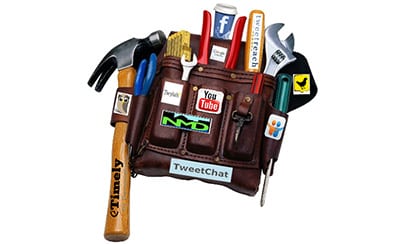
Navigating the world of social media tools can be a daunting task; however, it is a critical one for digital agencies. Today more than ever, social media teams need tools to organize, monitor and scale the growing pool of over 2 billion active social accounts.

Recently our team demoed 10 social media tools to uncover the latest technology to support our social clients. We walked away with not only a winner, but seven notable strategies everyone should incorporate into their social tool search.
- Choose a Spearhead. As your team works at its characteristically fast pace, streamline the process for everyone involved by having one point of contact for vendors who will be the first to vet each tool. This person should bring his or her top three recommendations to the team.
- Crunch the Numbers. Pay attention to the pricing structure. Some tools charge by the number of user log-ins, which is great if you have a small team. More complicated pricing structures charge by mentions per month, which can make budgeting difficult if you aren’t able to estimate how many mentions you may garner. Another method is paying per client or industry so that you don’t have to absorb undue costs if your client’s contract is up mid-year.
- Get Demoing. Set up a time with your rep to demo the top tool contenders. As your rep takes you through his or her undoubtedly pristine dashboard, inquire about how long it would take to custom-build for your clients, and pay close attention. Is it intuitive? Are there any technical glitches during your demo? If the rep says it’s not a big deal or typical occurrence, that doesn’t always stand true.
- Take Diligent Notes. Each tool will tout specific differentiators, but after demoing a handful it’s easy to mix up unique capabilities and forget which tool you preferred for social listening versus the one you thought was great for identifying influencers.
- Get Served. How active are the customer service reps throughout the demo process? This is an indicator of the help to come. If your rep takes a couple days to answer your emails while pitching you the product, you can likely expect an even longer response time after you’ve signed the contract. Also secure a day-to-day customer support rep and ensure the service hours are during your work schedule. Will he or she provide in-person training to your team or—even better—build your first dashboard?
- Push for More. Free tool trials are sometimes not offered until you ask. Having time to explore the platform is paramount, because this is when you’ll decide if the tool provides actionable insights for your clients. Secure references, customer reviews and case studies to see the tool’s performance through hard data and current clientele without a sales agenda.
- Look Ahead. Before you choose a partner, confirm that their growth strategy aligns with yours. For example, if you’re looking to build a robust Pinterest strategy next year, confirm that the partner either has access to the Pinterest API or will by a date that works for you. Ask your rep if he or she can share a roadmap so that you don’t sign a contract with full access to Instagram insights today, only for those insights to be cut tomorrow.
Only your team can identify the unique goals you wish to exceed and the tools that will help get you there. Armed with these tips, you’re better prepared to choose a long-term partner and avoid this being an annual process.
Caitlin Wolf is the director of public relations and social media at Planit, a strategic, digitally minded brand agency that leads revolutions for national and global clients including AGCO, Marriott International, McCormick Foods and Universal Music Group. She can be reached at [email protected]. Follow Planit: @planit.
